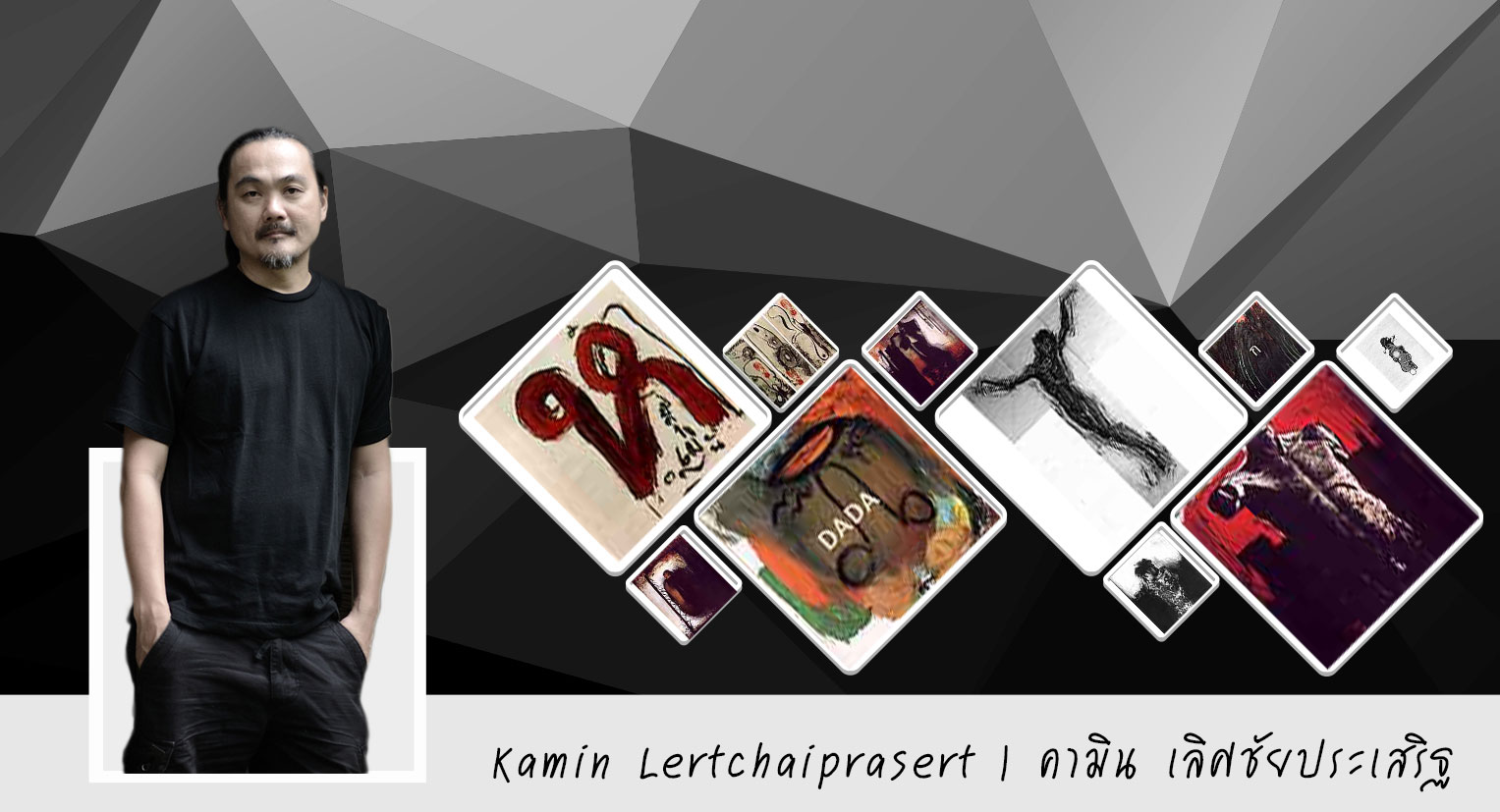

| I believe | in Buddhism. |
| I believe | that everything is empty. |
| I believe | that emptiness is the origin of nature, the universe, energy, matter and life. |
| I believe | that life has two essential components: body and mind. |
| I believe | that the mind directs and controls the work of the body. |
| I believe | that the body is constantly changing. |
| I believe | that the original state of mind was empty and unchanging. |
| I believe | that in all ages and periods mankind through efforts to understand nature, created the various branches of knowledge such as religion, philosophy, science, art and so on. |
| I believe | that everything is inter-related. |
| I believe | that an understanding of the nature of our minds enables us to understand nature, outside ourselves. |
| I believe | that art is one path that will lead us to understand the truth or our own nature. |
| I believe | that the process of creating art, enables us to understand our own nature just as the process of practicing Buddhist dhamma meditation does. |
| I believe | that the true worth of art resides not in its beauty or utility but in its spiritual value. |
| I believe | that if we understand the original state of mind and the working of our mind we will understand the primary source of happiness and suffering and we will be at peace. |
| I believe | that the world will be at peace when minds are peaceful. Kamin Lertchaiprasert August 1, 1996 |
| http://www.31century.org |
| 1964 | Born in Lopburi, Thailand. |
| 1968 - 1971 | Attended bording SchooI at Charouklom Withaya, Lopburi. |
| 1972 - 1974 | Attended bording school at Samook Chistain Withaya, Chonburi. |
| Interested in God. | |
| 1975 - 1977 | Moved to Bangkok |
| Attended school at Sritabhut Bumroong, Bangkok. | |
| 1977 | Interested in Art. |
| 1978 - 1981 | Attended College of Fine Arts, Bangkok. |
| 1981 | Changed name from ''Muangnging Sae Lao" to "Kamin Lertchaiprasert". |
| 1982 - 1987 | Attended Silpakorn University, B.F.A. in Print making. |
| 1982 | Interested in Photography. |
| 1983 | Lost my mother from an accident. |
| 1984 | Travelled in Europe |
| 1987 | Interested in Photographs and Prints. Selected "Out Standing Young Artist of the Year" by the Silpakorn University Art Gallery. |
| Moved to New York City, U.S.A. | |
| Worked at Photo Shop. | |
| 1988 - 1990 | Worked as a busboy. |
| 1989 - 1990 | Attended "The Art Student League of New York" |
| Worked as a printer for other artists. | |
| Broken heart. | |
| 1990 | lnterested in eastern philosophy. |
| Desired to give up being an artist. | |
| First time came back to Thailand. | |
| Became a monk. |
CONCEPT:
The feelings of loneliness, painfulness and depression have always been buried in my mind all the time, owing to the environment and the experiences gained in the past, such as ' the loss of my mother due to accidence and sorrow for my wrong - doing committed at various ages.
These experiences have deeply affected my attitudes and imagination, given impetus to the recording of love, grievance and suffering, which seems to be the only way of expressing that which I can not express in words.
The Exhibition of Photograph and Print
on 9-30 January 1987, at The Art Gallery Silpakorn University, Bangkok
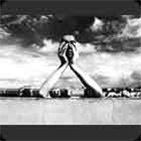
Alone, 1983,
Photograph, 51 x 61 cm.
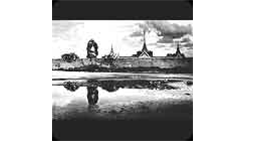
Pressure No.4, 1983,
Photograph, 51 x 61 cm.
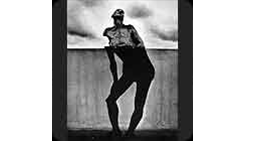
Suffering , 1983,
Photograph, 51 x 61 cm.
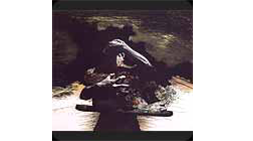
Suffering No.7, 1985,
Photo - etching, 75 x 88 cm.
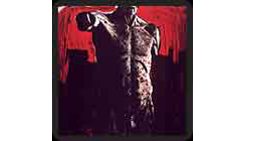
Men 2529, 1986,Photo - etching,
Photo - etching, 71 x 73 cm.

Self - portrait, 1985,
Photo - etching, 71 x 73 cm.
CONCEPT:
"GAW ERY GAW GAI"
These are simple words that have a strong relationship with Thai people.
They are the first words used by children learning to read and write the Thai language. Just as the first important words a child speaks could be "meh" (ma), the first words every school child learns are "GAW ERY GAW GAI"
About 700 years ago the King of Thailand created the Thai alphabet. Because of him, we established our own language. I believe this became the focal point of the Thai spirit and identity. The language drew us together, gave us our unique personality, and embellished the culture and independence of our nation.
Nowadays Western culture has influenced our way of life. Thai culture and traditions changed to go- along with the technology of Thailand's modern society. Geared to an international lifestyle some part of its value and beauty slowly evaporated.
In this "GAW ERY GAW GAI" series I want to highlight that part of our Thai identity in culture and tradition that remains in me and every Thai person throughout his life. These traits are imbued in us from the time of birth through the medium of )ur language. In the same way I hope my work gives you thoughts of the human ,alues inbred in us, appearing in the joyful, happy time of childhood. These feelings Nhich are in our memory can be recalled through "GAW ERY GAW GAI'.
Kamin Lertchaiprasert
May 8, 1991
The Exhibition of "GAW ERY GAW GAI"
on August 14 - September 11, 1991 at Visual Dhamma Gallery , Bangkok
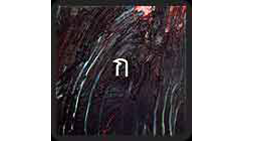
Thai Painting ก , 1991,
Acrylic on canvas, 24 x 24 inch.
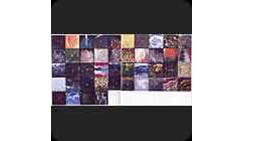
Thai Painting 1990-1991,
Acrylic on canvas, 44 Pieces,
Each one 12 x 12 inch.
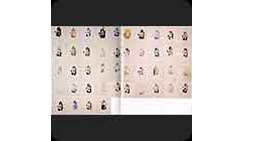
Suffering , 1983,
Photograph, 51 x 61 cm.
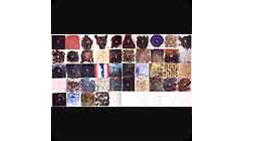
Thai Drawing 1991,
Acrylic and cuted paper, 44 Pieces,
one 22 x 22 inch.
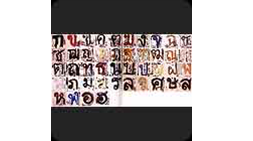
Thai Poem 1991,
Each Acrylic and charcoal pen oil on paper, 44 Pieces,
Each one 22 x 22 inch.

Thai Dialogue 1991,
Etching and hand print , 12 Pieces,
Each one 30 x 40 inch.
CONCEPT:
NIRAS THAILAND
July ' 91... I was back in Thailand ... again...the second time after my long years away ... in the U.S ... During my three months of rest I traveled far and wide ... Chiang Mai ... Samed ... and other places. I recored what I saw along the way,and what I heard and felt. My feelings are reflected through my photographs and poems. Not only did I record my travels but also every day experiences and common events. I called my journal "NIRAS THAILAND"
My Journey was motivated by the travelogues of Sunthorn Phoo,one of the greatest Thai poet laureates. I know my humble "niras" is by no means as elaborate as those gems of Thai literature. Instead of using the traditional rhythm and meters of Thai verse, I wrote in simple everyday language. My emphasis is not on the beauty of language but the beauty and value of life.
Each day,walking about in my sandals, I took photographs and wrote poems to express my thoughts. And on each, when I returned.... I would stamp my rubber sandle,in whose sole I had carved my name.
I do not mean to affront or be discourteous to anyone in using the foot.
I realize that in the Thai context,the foot, as the lower part of the body signifies something rude and uncultured. I do this for several reasons. First the footprint is used as a symbol of my travels. Next it is a signature, like a Chinese " chop mark" on my work. More important it is motivated by the " Buddha Footprint" , an object held in reverence by the Thais, located in Saraburi Province.
As a printmaker I keep asking myself how the art of print-making originated? Couldn't there be some connection between the" Footprint " and the origin of printing art ? Were the imprint of humar footprints or vehicle traces carved in the earth, the forerunners of the concept of printmaking ? Therefore was the " Buddha Footprint " found in Thailand about five centuries ago,the spark of inspiration that kindled the development of printing art in Thailand ?
My experience in living abroad for many years has made me understand the differences between the cultures, philosophies and life styles of Western and Eastern peoples. I have also seen a similarity in material interests such as money, fame and power. These have become important parts of our modern life and became a cause of many problems in our society.
In my " NIRAS THAILAND " photographs and poems I want to accent what I feel are the true values of life that I believe remains in us.
I hope these works can make us realize that the values of love,charity and sympathy for each other underlie our every day experiences and activities.
When we recognize this commonality of our lives we can live together peacefully in society.
Kamin Lertchaiprasert
5 March 1992
The Exhibition of Niras Thailand in Poem
on 1-21 October 1992, at CON-tempus, The Bangkok Fine Art Center, Bangkok
The Exhibition of Niras Thailand in Printmaking
on 1-24 October 1992, at Dialogue Gallery, Bangkok
The Exhibition of Niras Thailand in Drawing(to spirit)
on 2-21 November 1992, at The Art Gallery of Faculty of Painting, Sculpture&graphic Arts,Silpakorn University, Bangkok
The Exhibition of Niras Thailand in Photographs
on November 26 - December 27, 1992 at Silom Art Space, Bangkok
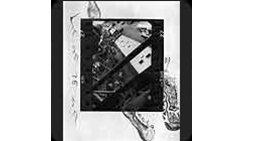
Niras Thailand in Photograps,1991,
Photograph, 20 x 24 inch.
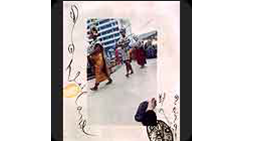
Niras Thailand in Photograps, 1991,
Photograph, 24 x 20 inch.
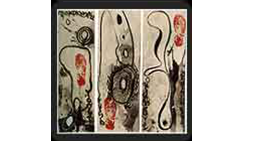
Niras Thailand in Poem, 1991,
Acrylic and charcoal on paper, 104 Pieces,
Each One 40 x 14 inch.

Niras Thailand in Print making, 1991,
Rubbing on Sa paper, 24.5 x 50 inch.
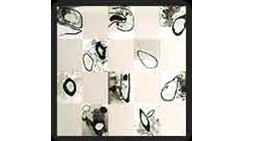
Niras Thailand in Poem, 1991,
Acrylic and charcoal on paper, 1000 Pieces,
Each One About 8 x 10 inch.
CONCEPT:
Ever since I was born. I'd always heard the name "Muangnging" mentioned and had felt related to it. Although now I hear only "Kamin", when somebody says "Muangnging", I just can't help recollecting the happiness, misery and everything else in my childhood. Most of the things I remember vividly are my childhood mistakes. I was a very naughty and good-for-nothing child who did not know what schooling meant. My teachers usually found me a troublesome kid-because I was not at all attentive, did not do my assignments, had fights with friends and did many other things which I'm too ashamed to mention here3
I still remember that every time I had problems, I used to solve them by finding "reasons" and excuses to try and convince others that I was right or sometimes I put the blame on others, on social rules, and sometimes even on God. Of course I never questioned whether all the problems had arisen from myself.
As I grew up, it seemed as if problems in my childhood disappeared and were replaced by those of a different nature which, as children, we never paid any attention to or were even aware of, although they truly existed. In our present-day society, if we look at it from the outside, we won't feel that there existed that many problems, maybe because we are too close to them and, as time has gone by, have got used to them. It's also possible that, with certain problems, we are not directly affected by them. However, once we have come to really think of them, we will find that nearly everything around us has become one kind of serious problem, such as :
1. Environmental problems: air and water pollution, deforestation and the destruction of other natural resources.
2. Health problems: AIDS, wretched mental health, food poisoning, drug etc.
3. Political problems: wars,lack of public freedom of speech and expression corruptions.
4. Economic problems: unemployment, the low income of the majority of people, child labour, and labour exploitation.
5. Cultural problems: religious and ethical decline, child prostitution, murders and rapes. All these problems in our society are getting worse and worse day by day. They are interrelated directly and indirectly. They also extensively effect other nations throughout the world.
Very often I have asked myself how these problems occurred and how they could be solved. This has brought me back to the problems in my childhood and, once again, I ask myself how problems which were my own fault in my childhood, occurred. The remarks and questions I have come up with are :
1. Was it my natural inner desire that propelled me into mistakes and evil things? or 2. Was it cultural and social influences? or 3. Might those problems not be problems but merely one aspect of man's natural behaviour which happens to contravene the conditions and agreements of customs, cultures, beliefs, social rules and the laws of particular times?
It was then that I became interested in child behaviour as well as children's artistic creations, which reflected their thoughs, I find it very obvious that all children express themselves in similar forms of art, without any particular art style. The technique they use are obviously very simple, reflecting the freedom of expression according to an individual's experience. In their creation, there is no right or wrong in art rules and aestheticism. Their expression is part of their inner nature and is in fact mingled with the whole nature of the world. For this reason, I believe children's art is pure art and is naturally universal. In the same way, I believe a child's mistakes are undeniably pure and natural.
In this "Muangnging Sae Lao" series, I've been inspired by children's creation of art works, especially the direct expression of their knowledge and individual's experience. Also I have presented my personal experience as well as illustrated ongoing social problems the way they actually happened. I hope very much that this series will enable I and you to realize the fact that we all take responsibility for the problems in our society. Also, I believe that problems will decrease only if everyone starts to examine his/her own mistakes in his/her duty in the fairest possible way and accepts way and accepts them. Once we've looked at ourselves, we should try to sincerely solve the problems the best way we can before putting the blame on something else.
Kamin Lertchaiprasert
April 2, 1993
The Exhibition of Muangnging Sae Lao
1993 at Dialogue Gallery, Bangkok
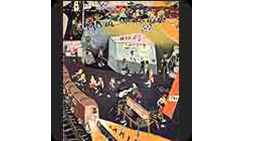
My home is on 57 st. 7 AV.,1992,
Oilstick on canvas, 60 x 48 inch.

She was raped in Central Park,1992,
Oilstick on canvas, 60 x 48 inch.
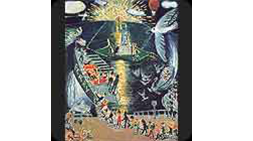
Jonathan Seagull and I looking for liberty,1992,
Oilstick on canvas, 60 x 48 inch.
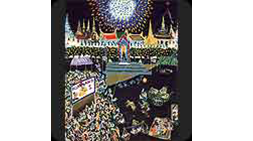
King and I,1992,
Oilstick on canvas, 60 x 48 inch.
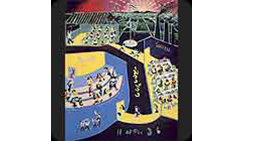
Woman Woman Woman School Factory Hotel, 1992,
Acrylic on canvas,60 x 48 inch.
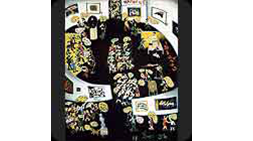
Silapin - Silaprau, 1993,
Acrylic on canvas, 60 x 48 inch.
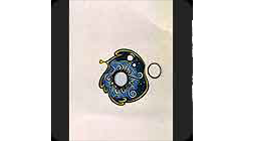
What's in My Mind, 1993,
Oil pastel and charcoal on paper,
30 x 22 inch.
Exhibition Room

CONCEPT :
The world has become more and more materialistic.This is because of the technological advances of the western world which have affected cultures of nearly every country all over the world, particularly Thailand, which is a developing country and other developing countries as follows:
1. The rapidly expanding economics has caused traffic problems, pollution problems, and crowded environment problems.
2. The changing cultural values which have been influenced by western culture e.g. clothing, art, movies and music have led to conflict of beliefs, local cultural values, religious beliefs and old traditions.
3. The change in the modern way of life namely housing and catering has caused the imbalance in local natural resources, which is contrary to the simple way of living of the past that was appropriate the climate
4. The fact that the industrial growth is more rapid than that the knowledge and understanding of the people who make use of it has been more negative rather than positive. For instance, farming and industry which focus on the outputs without considering the side effects, such as pollution and workers' and consumer's security .
I can't reject the materialized civilization or western cultures. However, I would like us all to be aware of what we originally possesed and what we want to bring about, adopting this to be relevant to our own culture. And that we should not just copy everything without considering our culture, ways of living, geography, philosophy, and religion.
From my art experiences, I would like to express my opinion about the problems of changes of art and cultural values, which results from the western cultures, especially that of fine arts through this ABC project. Here ABC symbolizes the western cultures.
Most contemporary arts have been based upon western art history, for example; evaluation, tastes, aesthetics, styles, expression, artistic theories and art educational systems. All these have been defined according to the western standards. This has become our cultural problem without our being aware or fully understand the real cause of the problems such as;
1. The problem about educating people in the society, namely Thai people, cannot appreciate contemporary Thai arts without studying western art history.
2. The problem about conficts of beliefs regarding morality, cultures, traditions, religion and life philosophy since the values of these have been defined according to the western values, especially among new generations.
Through this ABC project, I have presented my personal point of view that art is natural in every human being no matter what class, occupation, race, culture, and religion, and that art is a universal virtue, like the virtue in children's art which is not specified, its virtue in educational knowledge, values, beliefs, tastes, aesthetics, styles art theories and educational systems based on either western or eastern art history.
The Exhibition of ABC
on 3 April - 4 May, 1995 at British Council, Bangkok
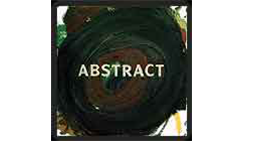
A...ABSTRACT, 1991,
Oilstick on canvas, 12 x 12 inch.

D...DADA, 1991,
Oilstick on canvas, 12 x 12 inch.

Y... YOUR-ART, 1991,
Oilstick on canvas, 12 x 12 inch.
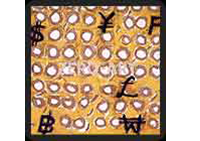
Z...ZERO-ART, 1991,
Oilstick on canvas, 12 x 12 inch.
Exhibition Room

The Exhibition of "Problem - Wisdom"
1998 at Queenland Art Gallery, Australia
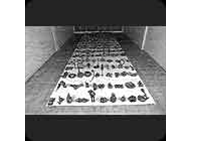
"Problem-Wisdom"

Detail of "Problem-Wisdom"
"Live According to One's Circumstances"
Not Follow Passion, 1994, Paper-mache' sculpture 4 x 6 inch.
Exhibition Room

CONCEPT :
Normal & Nature
The body of every living thing exists and then disappears, always changing. If we get stuck in a rut thinking our body belongs to us, we will be drawn into the condition of suffering. Dharma teaches impermanence and what the enlightened Lord Buddha gave us is the nature law. I am a person who has faith in the Dharma preaching of the Lord Buddha and try to apply this knowledge to my everyday life ... including my artistic creativity.
I am of the belief that the process of creating art is a channel that allows me to realise the ultimate truth inside myself. Once we have seen this ultimate truth, we can then go on to discover the truth outside, in a., l process slmllar to mealtatlon.
In this set of work, the content deals with my daily experiences. As they deal with such subjects as love and relationships, hope, peace, suffering, anxiety, fear, greed, anger, lust and so on, the experiences are both positive and negative. I bring these works as "food for thought" so a viewer can ponder the emotions contained within. With the help of meditation I believe I can rationally realise the cause of each emotion without any bias toward each experience.
According to our physical make-up, digested food gives us energy that feeds our organs while the waste is turned into excrement and urine. Similarly, each days our mind perceives both positive and negative situations which can bring us contentment or distress. My bringing each daily experience for contemplation is thus similar to the human digestive system. I pick subjects which will "feed" my spirit using the kind and impartial parts of my mind. I screen out all things that can bring me sinful thoughts.
Generally however, experiences both merciful and sinful remain imprinted on a person's sub-consciousness every time he or she comes across them. Moreover, once a person accumulates a certain number of experiences they are transformed into a thinking-action-familiarity-habit; a habit which will dictate a person's way of living.
During the past year spent creating this Normal & Nature set of work, I have realised the process of making art can also lead me towards a more conscious way of living. I have come to realise that, by following the Lord Buddha's nature law, I can live peacefully within society.
Kamin Lertchaiprasert March 24, 1997 English translation ~oy Patara Danutra
The Exhibition of "Normal & Nature"
1997 at Faculty of Fine Arts, Chiang- Mai University, Chiang Mai, Thailand
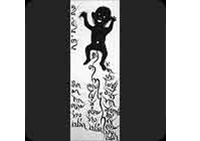
Normal & Nature14/8/95,1995,
Charcoal on paper, 100 x 35.5 cm.

Narmal & Nature 15/8/95
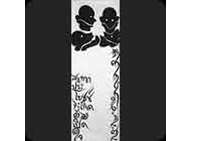
Narmal & Nature 16/8/95
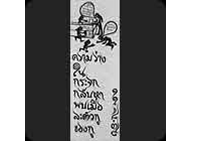
Narmal & Nature 11/8/96
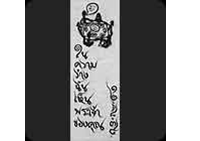
Narmal & Nature 12/8/96
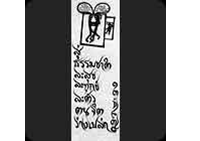
Normal & Nature13/8/96,1996,
Charcoal on paper, 100 x 35.5 cm.
Exhibition Room

CONCEPT :
I believe : that the process of creating art, enables us to understand our own nature just as the process of practicing Buddhist dhamma meditation does.
The Exhibition of Anitjang Thukkhang Anita
6 November - 2 December 1999 at Numthong Gallery, Bangkok
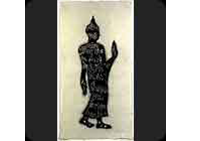
Anitjang Thukkhang Anata,
1997, Chacoal on Sa paper,
128 x 68 cm.
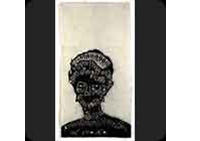
Anitjang Thukkhang Anata,
1997, Chacoal on Sa paper,
128 x 68 cm.

Anitjang Thukkhang Anata,
1997, Chacoal on Sa paper,
128 x 68 cm.
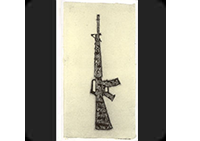
Anitjang Thukkhang Anata,
1997, Chacoal on Sa paper,
128 x 68 cm.
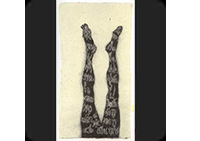
Anitjang Thukkhang Anata,
1997, Chacoal on Sa paper,
128 x 68 cm.
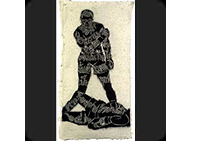
Anitjang Thukkhang Anata,
1997, Chacoal on Sa paper,
128 x 68 cm.
CONCEPT :
Time and Experience 1990
Time and Experience 1990 was the first set of works in which I emphasized the importance of the process of creating rather than the art object itself. It was made about ten years ago when I was living in New York. It was at this time that I was searching for and confused about the meaning of life and art. What is it? What is it for? And what is the true value of it? How are we going to get to the ultimate understanding of it?
I used to think that art is an extremely creative discipline. However, in comparison to the field of science, I believe the knowledge and crecfivity in scientific discovery by scientists reflects more tangible evidence than art. Also, I used to believe that art has a strong spiritual value. Again, though, when compared to another field such as religion, religion has more intangible spiritual value for one's soul and mind without having to necessarily communicate through visual representation, unlike art. All of this confusion happened to coincide with my own personal problems about love. It was a disastrous period.
During this time, I began to spend a lot of time reading all sorts of books that I believed would help me to gain real understanding about the true value of life and art. Most of these books were on religion and eastern philosophy as well as thoughts and inventions of scientists.
The knowledge I gained from thoughts on eastern philosophy helped me to understand the value of life at a present moment in time, The way to develop consciousness is to make the best out of the 'now' in every daily activity one does in living, The awareness of one's emotions, feelings, and internal thinking leads to the process enabling one to understand, control, and examine the real cause of each of these consequences. This is the way of living an art (full) life. This is the way to understand nature based on meditation or exercising the consciousness by observing nature, the physical body, emotional feeling, and thinking internally.
The knowledge I received from the approach of pure science was the way in which systematic experiments using tangible materials are based on logic and reason. Science is the process of understanding the external elements through the observation of external, natural phenomena combined with mathematical knowledge. The spiritual nature of the observer was not brought into consideration.
I was very impressed with Albert Finstein's way of thinking, which expressed that we become aware of time because of the experience that comes in the Interval between time. Each person's time is different. Time is inconsistent with the condition of each person's mind. For example, when sitting in front of a very hot fire for one hour, we will feel that time passed by slowly. But, if we are with someone we love, one hour will pass by very quickly. All of this depends on the state of mind of each person at that pcrticular moment Einstein also said that time we spend in daily life is not fixed or finite, We can interfere with time if we move fast enough because time is based on the speed of the traveler as posited in Einstein's theory of relafivity. Time is relative. The vcrying speeds of fime passing by, be it slow or fast, is relevant to the rate in which each object moves in space. For example, 365 days on the planet earth is equivalent to one year. But I day on Venus is equivalent to approximately 1 yearbecause Venus itself rotates around at the some rote as it rotating around the sun, Hence, time on earth is different from time on Venus. Einstein's theory about time made me re-think and begin investigating the value/ worthiness and universal truth of things within ideas, knowledge, belief systems, social customs as well as my own personol self.
I am using the art-making process as a way to understand my internal nature, just like art therapy. I combine it with the eastern philosophical way of thinking about the value of contemporary life. I express the observations of my emotions, my intelligence, and the feelings inside me in the form of tangible representation, I use different colors to represent intangible emotions and feelings (for example, yellow represents cheerfulness, peacefulness and comfort; red and pink represent love and high spirit; gray represents loneliness, sadness; and black represents sorrow, fear, etc.) and combine it with Einstein's theory about time. (The idea that we acknowledge time through interval experiences and that each person's time is unequal). I started to point and print one image of my own footprint each day for a period of one year in order to use my life experience every day as an interval of fime and then represent it in a tangible form. Starting from January 1" 1990 December 31, 1990, 1 put masking tape sequentially numbered from number one on the first piece unfil number 365 on the 365" piece in the middle of each canvas. I then applied colors to the canvas according to my feelings and emotions each day using my hands instead of brushes. I wiped my hands with the leftover point on my feet. I then imprinted my footstep onto a piece of paper which also had a corresponding number with masking tape on it. After the paint dried, I peeled the masking tape off of the canvas and the paper to reveal the true nature of the material. From my working experience, I concluded that art should be a bridge between eastern philosophical ideas and scientific ideology in order to understand the intangible forms of one's internal nature and to express this idea in a tangible form through the artmaking process. The process, for me, is quite similar to scientific discoveries based on the method of experimentation and the use of logic.
I place all the paintings, like tiles, over the whole floor in the exhibition spcice. Around the room, I attach all 365 prints of my footprint onto the wall. The audience will be walking or standing on my paintings while looking at the footprints on the walls. This is the process of reversing the conventional concept of perception. Things that ore customarily perceived through sight hove to be perceived by touch, The footprint symbolizes the foot. It is the physical organ that can sense things through touching walking, standing on pictures that are usually sensed through sight. One can now perceive the painting by touching rather than seeing.The reason behind this is so that the audience would have to think to achieve a greater awareness rather than just be concerned about the value of an 'art object'. This is a search for internal spiritual value, reflecting the importance of time and experience in daily life that posses by with every step one consciously makes.
Kamin Lertchaiprosert
15 August 2000
List of Exhibitions >>
Solo Exhibition "Time & Experience
1990" on Present Exhibitions in Rama IX Art Museum Web site

Solo Exhibition "Time & Experience 1990" on 4-26 November, 2000 at Namthong Gallery, Bangkok, Thailand
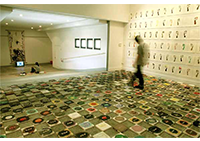
Solo Exhibition "Time & Experience 1990", 2000 at Faculty of Fine Arts, Chiang- Mai University, Chiang Mai, Thailand
CONCEPT :
The ordinary man is a Buddha. Passion is bodhi (the wisdom of enlightenment),
The foolish thought flowing through one's mind makes people ordinary men.
When thought becomes free of foolishness, followed by vividness, one becomes a Buddha. The thought that flows through the mind, which attaches it to emotion, is passion. The thought which comes afterwards, to release one's mind from attachment, is bodhi.
Voi Lang
The Exhibition of The Ordinary man is a Buddha
on 3-30 November 2001, at Numthong Gallery, Bangkok
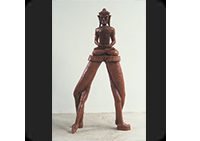
Unknown Detail
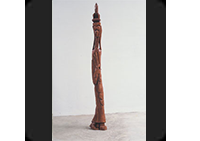
Unknown Detail
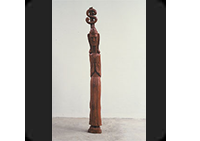
Unknown Detail

Unknown Detail
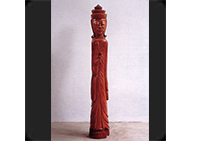
Unknown Detail
CONCEPT :
"Sitting 2004" is a continuous exhibition series of Kamin Lertchaiprasert.
VThe "Time and Experience" exhibition in 1990 was the starting point of Lertchaiprasert's interest in the process of arts creation, Eastern philosophy, scientific concept, as well as Albert Einstein's theory of relationship between experience and time -the idea of which his exhibition adopted its title from.
Lertchaiprasert first presented the journey of time in "Time and Experience".
He converted the familiar sensory perception of the audience by putting footprints on the wall and leaving 365 pieces of paintings on the floor (as the number of days in a year) so that the audience can step on it. Other exhibitions employing the similar methods of creation include "Kor Oei Kor Kai" (1991). "Travels to Thailand" (1992), "What's in my mind?" (1994). ABC (1995). and "Normal & Nature" (1996). There is also some subject-based exhibition taking turn with the aforementioned events such as Muang-nging Sae Lao (1992) or the solo exhibition "The ordinary man is a Buddha. Passion is bodhi (the wisdom of enlightenment)" (2001).
In that very same year of 1990. Lertchaiprasert began to explore the use of words as part of the images. The integration of words and images seems to be inseparable in his work since then. Words and narration reflect the intention of the artist and the issues of abstract e.g. forms or colors.
Researching his documents of the previous art pieces. one may come up with a statement recorded by Lertchaiprasert himself that he is very much interested in meditation. The artist's application of meditative gestures in the arts production process implies the idea of vipassanal through mindfulness. This unique aspect differentiates Lertchaiprasert from other typical Thai artists who prefer to portray Buddhism with its issues or terms through the subject-based processes.
Since the work is meditation centered. it is not easy for everybody to understand the implication behind it. Although Lertchaiprasert's background education is in Western arts. one can hardly refuse that his work does not purely contain Western way of thinking, Lertchaiprasert mentioned that ",,,/ adopted arts production to learn to understand both inner nature of myself and psychotherapy.." (Lertchaiprasert : 1990)
In the foreword of the Normal & Nature's catalog, he says that "... I fee that the creation of arts helps develop my attitudes to live my daily life with conscience..." (Lertchaiprasert : 1997). Despite these statements, his work may not be completely entitled as conceptual process art. Even though the process plays a leading role in the creation, the compressible meaning are equally significant and not insipid. The artist insists that the skills us d are spontaneous and the techniques are merely the medium in transmitting emotions and thoughts. Yet, his practice is not in the custom of arts but part of the contemporary current.
Nicolas Bourriaud says in Rational Aesthetics (Nicolas Bourriaud : 1998) that the conceptual art free from 1960s trend is the process related art such as those of Rirkrit Tiravanija, Philip Parano, or Vanessa Beacroft. Nonetheless. it is not apparent that Lertchaiprasert's work belongs to this category. Although his art has gone through certain processes, the creation is associated with "Meditation" -his daily routine which remains unclear in both Western and Eastern cultural contexts. Meditation is inexplicable in human words and not related to the universal cognizance. The intention. determination. and motive are full of abstracts and subjectivity. The meditation itself can also be viewed as vague and ambiguous. It can be simultaneous meditation like hile we are reading or playing Sports(Buddhadaspikku : 1958), or like what Lertchaiprasert practices everyday to examine the mutability, suffering, and vanity.
Understanding the perception of "Praying" is an essential part in meditation. Venerable Dr. W. Rahula says in "W at the Buddha Taught" that praying
"...aims to cleanse one's mind of all disturbances and to purify one's thinking for wisdom. Thus, it is difficult or almost impossible to judge a topic this way..." (W. Rahula : 1958). The coherence of body and mind implies that Lertchaiprasert's art pieces have naturally enchanting ambiguity of the relationship between emotions and reasons.
"Sittiing 2004" is part of the 365 drawings Lertchiaiprasert produced. The artist still holds nn to the Eastern philosophy and interactions between causes and effects, with which he relays his personal experience in daily life to the audience. The event is divided into two categories. The first section is woodcut prints on hand made paper. The prints show meditative gestures with dates of recording. The monochrome draings and wording share certain characteristics with Chinese calligraphy. It is in this part that one wouId sense the emotions in the artist's work even though it was processed through rationality. This makes Lertchaiprasert's art fresh and lively.
Another part of th exhibition is th reflections of two-dimension printmaking in the form of three dimension wood-carving sculptures, both narrating the same theme. In hartnony with the space of all three exhibition venues, the two sections generate two dimension and three-dimension implications of what the artist is trying to convey to the audience. The three-dimension sculptures may reflect different earrings from those of the two-dimension pieces.
"Sitting 2004" creates a more playf I and relaxing atmosphere. The images see to be teasing and fooling the audi nce. The pictures of a sitting figure is, in fact, the self portraits of th artist who reacts to the changing circumstances everyday. To portray his daily personal experience. symboIs are added to the images such as a pointed end on the head as that of a Buddha image or a round head as that of a human being. Some illustrates serious facial expressions while others teasing ones. Many images are surrealistic like Ultraman, a superman-like figure adored by many children. The message Lertchaiprasert would like to send to the audience is that caring for oneseIf couId make one's life much more meaningful.
The images in the artist's work are reflections of his personal life undergone the practices of scrutinizing and reasoning. He believes that this process teaches him about life as well as the balance of feelings and thoughts. The artist adopts the practices to analyze his daily life. In terms of meditation, he purifies his quest for wisdom.
In spite of the individ ality. the work portrays changes of the present with surrounding entities stated in the art piece no. 22/3/47 as "Contributing is the heart of a community". This art item depicts his daily life in connection with other situations, particularly "The Tunnel of Morality" or "The Land Foundation" project which he initiated.
If we rearrange all of the pieces, it seems that Lertchaiprasert's work since 1990 has explored the theme of time with the influence of the current changes to the past and to the present itself. The questions he raises are framed within a certain set of beliefs, The questions to his daily incidents or phenomenon. therefore, are more like the repeated practices than seeking for answers. Questions asked on a basis of beliefs are a pattern completely different from the Western contemporary conceptual process. Does this lead to reconsideration on the definition of time in Lertchaiprasert's art pieces since 1990?
Ark Fongsmut
List of Exhibitions >>
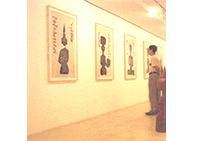
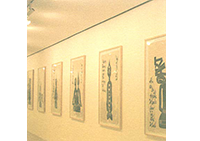
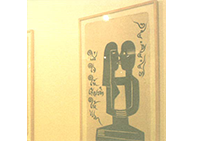
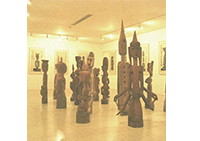
Exhibition of "Sitting" on April 1-24, 2005 at Art-U room, Jingumae, Shibuyaku, Tokyo, Japan
Exhibition of "Sitting" on October 16 - November 13, 2004 at Bangkok University Gallery (BUG) 3rd FL., Building 9, Bangkok, Thailand
Life-Emotion-Art.
From my experience of studying in the same class with Kamin Lertchaiprasert, it seemed that amongst art students of that generation, he was the most ambitious to become an artist. His interest in art tarted with photography, even though at the art institute attended, offered no course on photography; but as the energetic youngster he was, he investigated this field of art as Kamin's understands it. : "Art is an instrument to convey the emotions that evaporate insubstantially from life experiences".
When I first saw his early photography works ( Fig. 1, Pressure No. 4), I noticed two kinds of components, the figure of a real person and a sculpture of a human face, composed in different gestures, in the middle of a desolate environment and frightening atmosphere. These works refer to the connection between 'life and death' (represented by the harmonious composition of living subjects and non-living objects). At that time Kamin had just lost his mother who had a leg amputated before she died. Kamin was giventhe duty to make a substitute Ieg from paper for the Chinese funeral ceremony.
These 'insubstantially evaporating emotions from past experiences' also appear in Kamin's later graphic works, when he chose graphic art as his major field of study. His photographic work from then on developed through the process of print making.
An example of his work during the last three semesters toward his Bachelor's Degree is shown in ( Fig. 2, Myself No. 1). Here Kamin intented to show his guilt, which is connected with his childhood, through his work. His former photographic work was adapted by the special characteristics of the etching techniques, shown in the moving lines (aggressive and direct), and the rough surface laid upon the flat photograph, in order to represent the stressed emotions, evaporating and alienated from his inner self.

Fig.1 "Pressure No.4", Black-white photograph, 51 x 61 cm. 1983
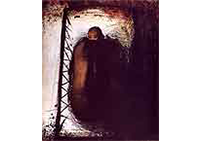
Fig.2 "Myself No.1", Photo-etching, 73 x 83 cm. 1988
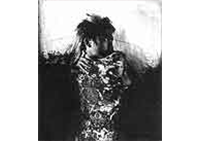
Fig.3 "One-self No.1", Photo-etching, 69 x 78 cm. 1988
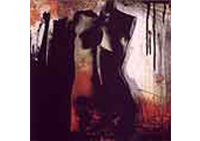
Fig.5 "Men", Photo-etching, 71 x 73 cm. 1986
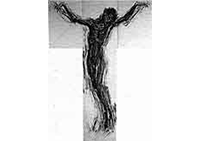
Fig.6 detail of "I look at myself", Oil on canvas, room size 14 x 16 F. 1988-1989
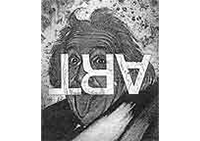
Fig.7 "Art No.1", Etching ,12.5 x 15 cm. 1990, Collection of Singapore Art Museum, Singapore.
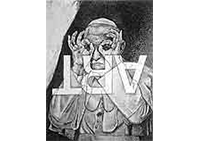
Fig.8 "Art No.2", Etching, 12.5 x 15 cm. 1990, Collection of Singapore Art Museum, Singapore.
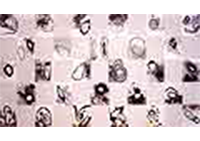
Fig.9 "Untitled", Drawing, Charcoal on paper 9 x 10 inch. each, 1990

Fig.10 "Thai Painting", Acrylic on canvas, 44 pieces, 18 x 18 inch. each, 1990-1991/p>

Fig.11 "Thai Painting", Acrylic on canvas, 24 x 24 inch., 1991
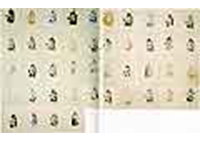
Fig.12 "Thai Print, 1991" Hand print, 44 pieces 11 x 44 inch each, 1991
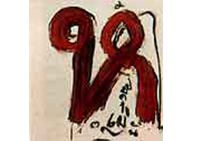
Fig. 13 Detail of "Thai Poem 1991" Acrylic and charcoal on paper, 22 x 22 inch, 44 pieces, 1991, Colletion of Thairaj
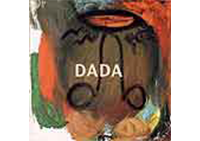
Fig.14 "D. Dada", Oilstick on canvas, 12 x 12 inch. each, 1991
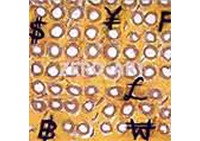
Fig.15 "Z Zero Art", Oilstick on canvas, 12 x 12 inch. each, 1991
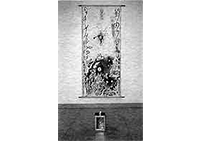
Fig.16 "Drawing to Spirit", at the Art Gallery of the Painting, Sculpture and Graphic Art, Silpakorn University, 1992
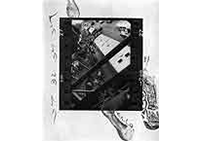
Fig.17 "Roat Roat Lade Roat" (Car Car Reduce Car), Black-white photograph and footprint, 20 x 24 inch., 1991
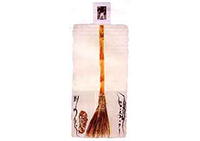
Fig.18 "Broomstick", Rubbing on sa paper and photograph, 24.5 x 80 inch., 1991, Collection of Queensland Art Gallery, Australia.
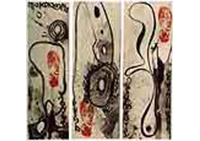
Fig.19 "Niras Thailand in Poem", Acrylic and charchoal on paper, 104 pieces, 40 x 14 inch. each, 1991

detail of Fig.16 and Fig.20 burning drawings
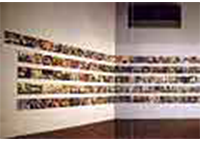
Fig.21 "Muangnging 1991-1992", Oilstick and acrylic on canvas, 366 pieces, 12 x 12 inch. each, 1991-1992 at the National Gallery, Thailand
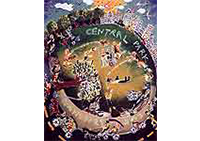
Fig.22 "She was raped in Central Park", Oilstick on canvas, 60 x 48 inch, 1992
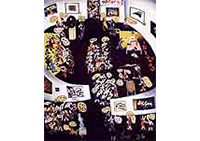
Fig.23 "Silapin-Silaprau(Artist-Dirty Art)", Acrylic on canvas, 60 x 48 inch, 1992
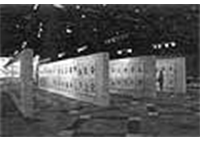
Fig.24'What's in My Mind" Oil pastel and charcoal on paper, 365 pieces, 30 x 22 inch. each, 1992-1993
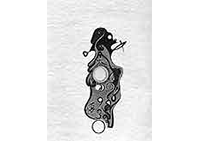
Fig.25 "Art is not Silapa, 12 June 1993" detail of "What's in My Mind"
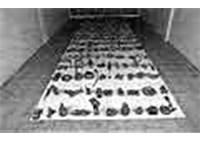
Fig.26 " Problem-Wisdom", Paper-mache sculpture, 366 pieces, 4 x 6 inch. each, 1993-1995, Collection of Queenland Art Gallery, Australia
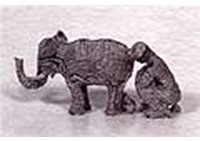
Fig.27 "Live According to One's Circumstances", Not Follow Passion, Saturday August 13, 1994" detail of "Problem Wisdom"
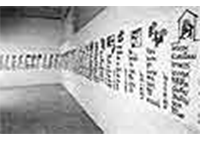
Fig.28 "Normal & Nature", Charcoal on paper, 366 pieces, 100 x 35.5 cm. each, 1995-1996